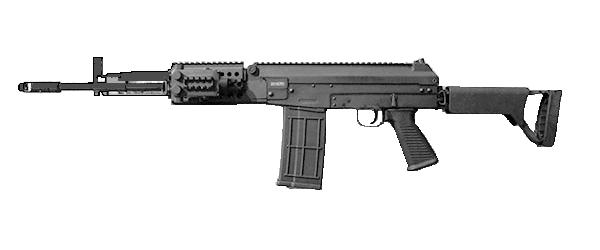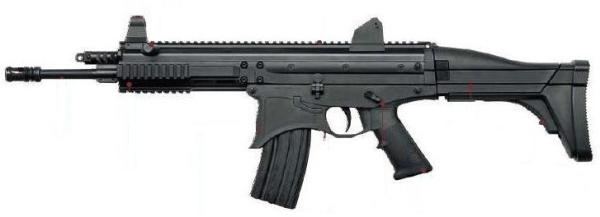- Joined
- Jun 16, 2016
- Messages
- 502
- Likes
- 620

MPAR 556
Unveiled in 2013 by Masterpiece Arms, the MPAR is a rare US assault rifle that doesn’t use the AR-15 as its basis.
As a matter of fact, the MPAR 556 was influenced by another creation of Eugene Stoner, the AR-18 with its gas operated short stroke piston. Appearance-wise, however, every detail of the MPAR 556 appeals to a shooter with a sensitivity for AR-type rifles.
Chambered for 5.56m rounds and designed for accessorization, the MPAR features not just a side folding but a retractable stock as well. Its anodized aluminum receiver supports a unique left-handed charging handle and a freefloating detachable handguard lined with circular gas vents and Picatinny rail amounts. As a bonus, a curved foregrip allows for ergonomic handling.
Like the majority of assault rifles today, flip sights are mandatory. It’s unknown if the MPAR is being marketed for export, but it’s available to US civilians as a sporting rifle.

MSBS Radon
The existence of the Radon dates to 2007. But it first came to light at an arms show in 2012 when publicly displayed by its manufacturer. Based on its appearance, it adheres to the standards of the Adaptive Combat Rifle, the FN-SCAR, and the H&K G36.
Although chambered for the 5.56mm NATO round, a 7.62mm variant of the Radon is being developed. This is understandable, considering it will be issued to Poland’s military in the coming years.
According to Polish Defence Holdings, a state-run arms exporting agency, the Radon’s essential part is a universal upper receiver that can be configured for any mission, be it a carbine or a marksman rifle.
Judging by available pictures, however, the Radon is meant to be very modular, with all the usual tactical attachments, even alternating configurations like a bullpup CQB variant.

Multi-Utilization Rifle
The MUR is a rare and generally mysterious small arm that came to the Internet’s attention several years ago.
Originating from Taiwan, a country with an advanced arms manufacturing tradition, the MUR appears to be an indigenous attempt at replicating the well-known FN SCAR.
The MUR thus appears to be a hybrid, combining an AR-type lower receiver with a presumably gas operated short stroke piston design. A milled upper receiver supports an ambidextrous charging handle and Picatinny rails.
If the MUR is the Taiwanese FN SCAR, then it’s a modular weapon of aluminum and polymer, with a side folding retractable stock to boot. Switching it to a different caliber is optional too.
The MUR is believed to be in limited use by the Taiwanese Army.

Norinco QBZ-95
It remains unclear when the QBZ-95 was first issued to the Chinese military. Even less is known about its development at a time when China’s economy opened up to the world in the 1980s and 90s.
What became apparent upon its first public display in Hong Kong during the 1997 handover to China is it represented a radical departure from the PLA’s prevailing infantry rifles.
The QBZ-95 is a bullpup design reliant on extensive polymer housing. It fires a unique 5.8x42mm round, a caliber allegedly superior to those used by either NATO or the Soviet Union.
The QBZ-95’s adoption eventually overshadowed the Type 81, a derivative of and an improvement over the ubiquitous AK-47, which China’s manufacturers have knocked off in the millions.
The QBZ-95 features a unique trigger guard doubling as a foregrip. Its stock flips open and houses a cleaning kit. A carrying handle also serves as a mount for optics and protects the bolt that’s configured the same way as the French FAMAS. The QBZ-95 supports rifle grenades and underbarrel grenade launchers, be they imitations of Russian, US, and European models.
The QBZ-95’s manufacturer, state-owned Norinco, sells a 5.56mm variant called the Type-97. Its only noticeable difference is the more conventional trigger assembly.
As the basis for a family of weapons, the QBZ’s lineage includes a machine gun variant with an extended barrel, a bipod, and a drum magazine; a sniper rifle; and a shortened commando carbine.

Norinco QBZ-03
The QBZ-03, also identified as the Type 03, is a conventional assault rifle with a gas operated, rotating bolt firing mechanism. Like all modern Chinese infantry small arms the QBZ-03 is chambered for the 5.8mm round. Judging by its appearance, the QBZ-03 is derivative of the Type 81 assault rifle featuring a polymer folding stock and a lengthened heat shield with air vents encasing the barrel assembly. Other improvements are obvious, like a simplified fire selector switch above the pistol grip and a side folding butt stock.
The engineers behind the earlier Type 81, a mainstay of the PLA during the 1990s, used the AK-47’s shortcomings as the basis for their new rifle’s appearance, which included a robust rear sight, a gas piston above the lengthened muzzle brake, and a Bakelite folding stock.The Type 81 is a hybrid as well, combining aspects of the SKS.
The QBZ-03’s two-part lower receiver is designed to accept M16-type magazines–the export version is chambered for NATO 5.56mm rounds–and its muzzle brake is different from its peer, the bullpup QBZ-95. The addition of Picatinny rails along its upper receiver means it conforms to ongoing trends in small arms.
Despite having been displayed in public, many are confused by the QBZ-03’s use. It appears the QBZ-03 is Norinco’s attempt at providing an infantry weapon that combines the Colt M4’s lightness and the reliability of a successful firearm.
 Norinco Type 81
Norinco Type 81The Type 81 assault rifle is a potent symbol of China’s modernization. Fielded in large numbers during the Deng Xiaoping-era, it marked the reemergence of the PLA from its late Maoist doldrums.
But the Type 81’s appearance betrayed its crude origins. Owing to the poor state of China’s local industry at the time, the original Type 81 was a hybrid of the AK-47 and the SKS that sought to overcome the limitations of either rifle. But when most third-generation rifles were using plastic and aluminum, the Type 81 was made of carbonized steel and wood, or sometimes Bakelite.
The Type 81 was doomed to infamy, however, and exported in limited numbers once it was replaced by the bullpup QBZ-95. Bangladesh is the only other country to produce the Type 81 under license.
China’s vast police force hasn’t given up on the Type 81. During a Beijing arms show in 2014 a new rifle was displayed by Norinco together with other “tactical” small arms.
It was a Type 81 chambered for the 7.62x51mm NATO round. To tickle the sensibilities of foreign buyers, it had an extensive Picatinny rail mounted on its stamped steel receiver, a side folding stock, and a new muzzle brake reminiscent of the AK-74.
Even without customers, it looks impressive.

OBR
Like many American gun makers Larue Tactical is riding the wave of AR-type rifles and carbines. To establish itself in the US, the company is marketing its OBR family, a series of firearms available in either 7.62mm or 5.56mm.
The PredatOBR, for example, is another attempt to overcome the M16’s limitations. The lower receiver is fitted with an ergonomic pistol grip and a magazine well for a 20-round clip.
More importantly, the OBR alters the direct gas impingement system for an adjustable gas block designated as the Port Selector Technology. Unique to the OBR, however, is the free-float handguard, optimized with gas vents and Picatinny rails, for its barrel assembly and the RAT retractable butt stock.
























